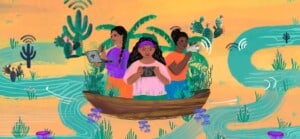By Candy Rodríguez
What if we design with our dreams (disoñar) in order to restore our information systems in Latin America? In our region, disinformation, digital divides, information monopoly, structural inequalities, hegemonic discourses, gender-based violence, low budgets to keep projects afloat, precarious employment for journalists, and the murder of journalists and community members are some of the factors that keep our information systems arid, dry and deserted.
In November 2024 we met sixteen people from twelve organizations from Latin America and the Caribbean in Santiago, Chile, to discuss how we can reforest and maintain our green information ecosystems. We participated La Sandía Digital (Mexico), Baudó Agencia Pública (Colombia), Social TIC (Mexico), Vita Activa (Regional), Proyecto Lava (El Salvador), Quid (Brazil), Nós, Mulheres da Periferia (Brazil), Sembramedia (Dominican Republic), Mutante (Colombia), LatFem (Argentina), Alharaca (El Salvador) and The Engine Room (Regional).
This gathering was conceived as a possibility to imagine achievable changes and to learn about proposals that are being implemented throughout the region. We reflected on the use of digital technologies and the importance of returning to analog, the possibilities of being able to talk to people in our communities and get to know each other more closely. Trust, support, cooperation and friendship are foundations that can facilitate other forms of communication.
We participated in nine collaborative sessions that took place over three days; we met, talked about our political positions, about feminisms, anti-coloniality, hope, the challenges we face as independent organizations, what our collective visions for the future are, how we are strengthened by collaboration, interdependence, and mutual aid, along themes such as funding, infrastructure, care, community, and decentralization.
We shared about some of the formats we have implemented to narrate and generate a real social impact; and with a critical vision we thought about what we wanted to take to our territories as a seed with possibilities to sprout.
Among the reflections that I would like to highlight are the following:
- Rebuilding the social fabric through neighborhood infrastructure: Work from the urban, we know that due to the configuration of cities and the rhythms of work, in which our homes only become bedrooms, does not allow us to talk , or know our neighbors. In this context, it is important to find ways to reach more communities through technologies that are within our reach.
- Strategies to decentralize from our territory and our work: Give ourselves the possibility to collaborate with people who are different from us; there are those who know the issues and those who know the technical aspects. Try not to repeat the same formulas that “supposedly work” and expand to other disciplines such as art and popular knowledge that are not usually at the center (for example, weaving). Put memory at the center. Diversify the sources and types of knowledge. Recognizing difference allows us to step out of our focus, not do capitalist journalism. Talking to our colleagues, recovering conversations with people who are not in our bubbles. Decentralize power and access to funding. Generate bridges between the digital world and the territory to get out of the echo chamber and above all to have patience with each other.
- What does it mean to be present as a social change project that works with media? Rethinking the logic of being present. Currently, to be present only means being present on social networks, to have more views, more likes, more followers. Communications teams are reduced to making calls to action through social media networks. We need to change the me, me, me, me, me that organizations do to question the competitiveness and break with capitalist and centralized logics. To be present is, for all of us, to have the possibility to recognize others and build collectively. In the Lava project, they narrate how people unite and bring together different skills, knowledge and dreams to face challenges. Collectivity is made by communities and this builds presence.
- Poder Jiji’s Recipe: There are no recipes without juicy funding. The first ingredient is a kilogram of conversation and community listening. 500 grams of imagination and narrative experimentation. Memory and narrative sustainability in the amount necessary to integrate the dough. Three cups of work with friends. Care and political self-esteem. A spoonful of empathy, enough to bring the bubbles closer together. A dash of artisanal and collective intelligence. 500 grams of diversity and 500 grams of coalition. A ton of hope and future. And as useful tips for the kitchen: form an alliance with more cooks. Make everything with a fun spirit, cook in the territories and share this recipe.
For us, it was very important to return to participatory work methodologies and allow body movement. We played, embroidered, listened, used the radio to experiment, made fanzines, drew, took pictures and concluded that we are women and we do not have to explain ourselves, we committed ourselves to use methodologies that return to the corporal; we took with us possibilities of alliance, to think of the network as a form of rhizome through nodes; to strengthen the concept of interdependence as something radically anti-capitalist; to connect individually and collectively. Listening to each other, talking to each other, taking care of each other and above all, the disposition to be able to build through learning-listening-teaching-collaborating.

